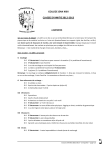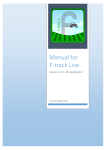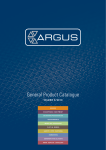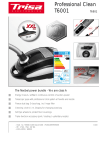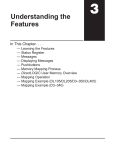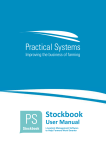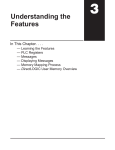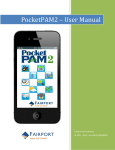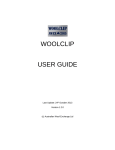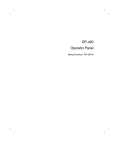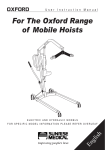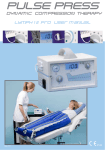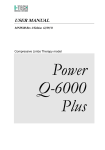Download Incoming Livestock and Slaughter Process Assessment Tool – Sheep
Transcript
Incoming Livestock and Slaughter Process Assessment Tool – Sheep User Manual This Manual provides additional information on a tool which can help you measure the effectiveness of your sheep dressing operation from the viewpoint of controlling faecal contamination of the sheep carcase. You can use the tool to assess your operation in several ways. For example, you can assess how well your process can cope with seasonal effects such as getting wet, dirty stock in winter and spring. Or you might want to measure the effect of accepting only stock with short fleeces and which have been crutched prior to delivery. Just punch in the answers and see how they affect your operation. Livestock Questions The following questions help you to assess various livestock characteristics influence hygienic processing of animals. The answers to these questions are combined to calculate a PROBLEM SCORE which estimates the problem you face when you slaughter animals with those characteristics. What percentage of sheep slaughtered have short (< 5cm) wool? Animals with long wool are harder to dress because of roll-back plus more chance of contaminating knives and workers’ hands and arms. Are animals crutched prior to slaughter? Crutching reduces the likelihood of contamination when opening cuts are made around the rump and hind legs. Are stock housed under cover? Housing animals under cover prior to slaughter allows the fleece to dry out. Dry fleece are associated with lower fleece and carcase contamination levels. Are the animals housed off the ground (elevated floor)? Housing animals off the ground removes faecal matte, leading to cleaner stock entering the slaughter floor. Problem Score The problem score is calculated as the product of the scores given for each of the questions. The problem score attempts to capture how big a problem a plant is faced with – the greater the score the bigger the problem. Processing Questions The following questions aim to assess the processing practices used at your plant. These practices have the potential to either control or worsen the incoming problem, and to influence contamination levels on finished carcases. The answers to these questions are combined to calculate a PROCESS SCORE which measures the effectiveness of your plant’s processes and procedures. The tool has been designed primarily to suit inverted dressing of small stock. If you have a conventional dressing system you can still get a result. Answer those questions which apply to your system e.g. 2-knife system, but use the NA (not applicable) option for operations which don’t apply to your system. It’s not perfect but it will give you some indication of how well you cope with the contamination levels on incoming livestock. Is the bung plugged prior to carcase inversion? Plugging the bung prevents leakage of faeces from the bung. It’s preferable to plug the bung before the carcase is inverted to reduce the risk of perforating the intestine. Do you use a 2-knife system? A 2-knife rotation system is considered superior to using a single knife which is washed under running water, and then dipped into 82°C water. Are two operators used at Y-cut? The Y-cut is a key operation which requires adequate time in order to be performed appropriately. Consequently, having two operators performing this task reduces the effective line speed at this key work station. Is legging paper routinely used to prevent roll-back? Roll-back is a major cause of microbial contamination of carcases, especially when animals have long fleece. Legging paper prevents the fleece from rolling back onto the freshly exposed brisket area. If you use legging paper only when specified by the customer, and not as a routine operation, you should answer this question answered with “no”. Do two operators clear the shoulders and foreleg? The clearing of shoulders and foreleg is a key operation which requires adequate time in order to be performed appropriately. Consequently, having two operators performing this task reduces the effective line speed at this key work station. Are hind legs lowered to prevent roll back? Engineering the chain to lower the hind legs when the brisket is cleared helps the fleece fall away from the freshly exposed brisket area, reducing the chances of roll-back. Do two operators clear the brisket for each carcase? The clearing of the brisket is a key operation which requires adequate time in order to be performed appropriately. Consequently, having two operators performing this task reduces the effective line speed at this key work station. Is the brisket hide removed or cleared and a pocket formed? Removing the brisket fleece allows the fleece on either side of the chest to roll-back once it has been cleared from the carcase. A superior operation is to clear the form a pocket under the brisket fleece and along the chest area. The fleece can then be rolled down the carcase in a similar fashion in which a sock can be pulled down a foot. Consequently, the hide area is fully enclosed, eliminating the potential for contact with the carcase. How many operators remove, clear, rod and clip the weasand? Removal, rodding and clipping of the weasand as separate operations, instead of as one operation is considered superior, because it allows the operator more time to complete the operation. How is the hide pulled back for the shoulders? Manual pull-back from the shoulders is considered superior to mechanical pull-back because when the fleece margin is pulled back mechanically it frequently drags across the shoulders, contaminating the carcase. Are cutting lines cleaned using steam vacuuming? Steam vacuuming removes visible contamination from the carcase surface through a nozzle which is bathed in steam. If vacuuming is confined to specific cutting lines e.g. the Y-cut, there may also be a microbiological effect because the steam is in contact with the surface long enough to kill some bacteria. Trying to vacuum large areas in a short time is partially effective in removing some visible particles but has no microbial kill. For this reason you should only select “Yes” if you target cutting lines. What type of punching is used to clear the hide? Roll-back of the fleece onto the carcase is more likely when automatic punching arms are used, so manual punching is considered superior in minimising roll-back. If manual punching is used, do operators have adequate time and facilities to wash hands and arms between bodies? During manual punching, one hand grips the hide while the other is used to separate the hide from the carcase. It’s important that operators have sufficient time and hand-wash facilities to clean themselves between carcases. Is the pizzle heat sealed and clipped? While urine is normally sterile following passage through the micro-filtration system of the kidneys, preventing urine contamination is considered an important aesthetic element in hygienic production. How is the hide removed? Manual pull-back of the hide prevents the fleece margin from rolling back. A rotary hide remover can put substantial pressure on the carcase and may squeeze faeces from the anus, especially when stock are scouring. Consequently, the use of a rotary hide remover is considered inferior to other methods. Are two operators used at bunging? Separating the bung is a key operation which requires adequate time in order to be performed appropriately. Having two operators performing this task on alternate carcases effectively reduces the line speed. Is the bung bagged and tied or is the anal canal tied and removed? Both methods, bagging and tying of the bung and tying and removing the anal canal, prevent leakage of faeces into the channel. Are two operators used at abdominal opening and stripping out? The opening of the abdomen and stripping out the intestine is a key operation which requires adequate time in order to be performed appropriately. Having two operators at this station effectively reduces the line speed. Are two operators used at pluck removal? The removal of the pluck is a key operation which requires adequate time in order to be performed appropriately. Consequently, having two operators performing this task on alternate carcases reduces the effective line speed at this key work station. Is line speed and manning level adjusted according to different lots? Line speed is considered to be important for hygienic processing. Adjusting it, and/or the number of operators at key work stations in response to the cleanliness of different mobs is an important management tool. What is the line speed (bodies per minute)? Line speed is an important variable in allowing operators sufficient time to properly carry out the required tasks and to complete decontamination of hands, arms and knives. Slower line speeds score better than higher line speeds. Process Score The process score is calculated as the sum of the scores to the individual questions, which are generally scored as “0” for the superior operation and “1” otherwise. An exception is the use of a 2-knife system, which is scored as “0” and as “5” for a single knife system. This is because using two knives impacts carcases at many work stations. The PROCESS SCORE attempts to capture how effective the procedures and operations at a plant are with respect to controlling the problem due to the incoming livestock – the greater the score the less effective the process. Total Score The problem and process scores are multiplied together to give a total score for a plant. A plant with a small total score is likely to manufacture carcases of high hygienic quality. What does it mean? In the table below, examples of two plants with very different scores are given. Plant A has a very low incoming problem – only short fleeced and crutched livestock with sourced. For Plant B almost the opposite occurs – almost all sheep have long, damp fleece and are not crutched. Consequently, the incoming problem for plant A is 0.02, which is about as good as it gets, while for plant B the incoming problem is 72, which is about as bad as it gets. When looking at the effectiveness of the process of the two plants, plant A scores considerably better as a result of most parts of the process scoring better. When considering the problem and process scores in combination, via the total score (obtained by multiplying the process and problem scores together) you can see that plant A has an excellent score, while the plant B score indicates processes which can’t cope with the incoming livestock contamination. How can the total score be used? Put yourself in the position of the QA / Plant Managers at Plants A and B. At Plant A you can see that the operation is about as good as it can be – clean livestock and a good process. If you managed Plant B, however, you can immediately see that the incoming problem is always going to be hard to solve on the factory floor unless you make radical changes. For example, plugging the bung immediately after bleeding, using a 2-knife system, using two operators at bung removal, bagging and tying the bung, and reducing the line speed to 8-10 bodies per minute would reduce the process score to 17 from 23, and the total score to 1224. Or, you could look at reducing the incoming livestock problem. Lowering the proportion of stock with long fleece to 20% and crutching them before slaughter would substantially reduce the contamination load you currently bring onto the slaughter floor (problem score of 1). So the tool can be used to predict various scenarios which impact on the hygienic quality of your carcases. It can also help you understand why you score well, or not so well, when the microbiological quality of your product is measured in baseline studies or in the ESAM program. Example scores for two plants Plant A 100 Plant B 90 Yes No Are the fleeces generally dry (due to undercover housing)? Are the animals housed off the ground (elevated floor)? Problem posed by incoming livestock Yes No No No 0.02 72 Is the bung plugged immediately after bleeding (prior to carcase inversion)? Do you use a 2-knife system? 0 1 0 1 Are two (or more) operators used at Y-cut for each carcase? Is legging paper used routinely to prevent rollback? Are two (or more) operators used to clear the shoulders & foreleg for each carcase? Are hind legs lowered to prevent roll back? 0 1 0 1 0 1 0 1 Are two (or more) operators used to clear the brisket for each carcase? Is the brisket hide removed or cleared and a pocket formed? How many separate work stations are used in weasand removal, rodding and clipping? How is the hide pulled back for the shoulders? 0 1 0 1 0 1 0 1 Are cutting lines cleaned using a Vacsan? 0 1 What type of punching is used to clear the hide? 0 1 If manual punching is used, do operators have adequate time and facilities to wash hands and arms between bodies? Is the pizzle heat sealed and clipped? 0 0 0 1 How is the hide removed? 0 2 Are two (or more) operators used at bung removal? Is the bung bagged and tied or is the anal canal tied and removed? Are two (or more) operators used at abdominal opening and stripping out? Are two (or more) operators used at pluck removal? Is the line speed adjusted during the shift based on manning and carcase cleanliness? What is the line speed (bodies per minute)? 0 1 0 1 0 1 0 1 0 1 1 3 Effectiveness of process 1 23 Total Score 0.02 1656 What percentage of sheep slaughtered have short (< 5cm) wool? Are animals generally crutched prior to slaughter?







